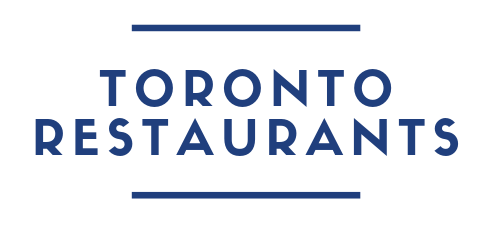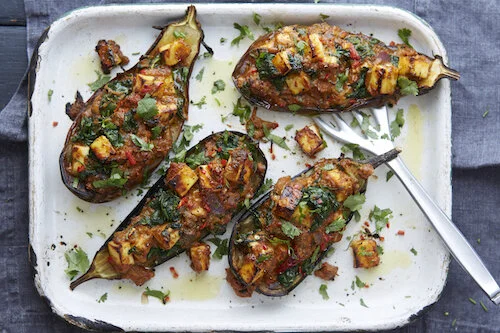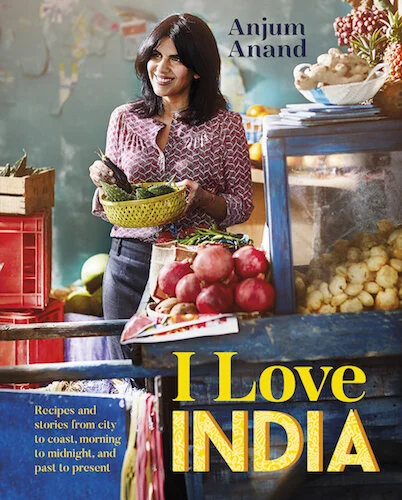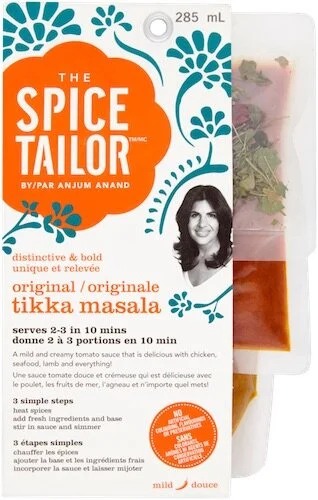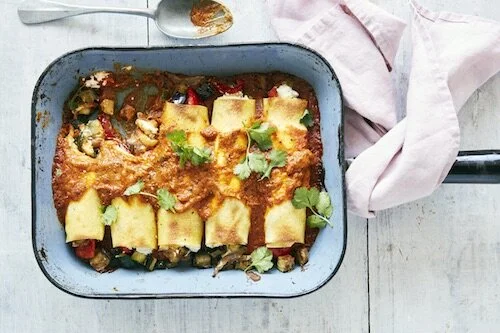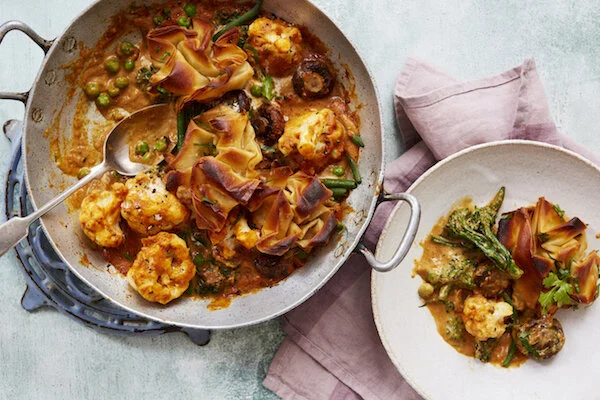Q&A with Anjum Anand - Founder of The Spice Tailor
Award-winning cookbook author and television host Anjum Anand is well-known in the U.K., but that’s all about to change, thanks to the recent launch of The Spice Tailor in Canada.
Her line of authentic Indian curry sauces (Classic Butter Chicken, Original Tikka Masala, Delicate Korma Curry, Fiery Goan Curry) and daals (Delhi Black Makhani Daal, Punjabi Channa Masala) - made without any artificial colours, flavours, preservatives or fillers - are serious game-changers, so go ahead and skip your meal kit delivery this week, because:
1. With these in hand, you can use whatever you have in the fridge and pantry, so you’re not tied to specific ingredients like those kits. It also means any meal can be meat-centric, vegetarian, flexitarian, etc., so you customize dishes accordingly.
2. They’re simple to use - Add each packet: one filled with fresh spices, one base sauce (or lentils/chickpeas if you’re making daal), and one main sauce.
3. Despite their immense ease, you still get the satisfaction of making a meal without any heavy lifting. Win-win.
4. Making Indian dishes from scratch can be intimidating to make because of the number of spices and ingredients involved. Here, all the guesswork is removed. Ahhh…
5. This simple yet ingenious method delivers an it’s-been-simmering-on-the-stove-for-hours depth of flavour without you having to be in the kitchen for more than 20 minutes. Try getting all that from a jar.
With the release of her latest cookbook, I Love India, and new sauce launching in Canada in a few weeks, it was the perfect time to get to know the woman behind the empire.
Anjum dishes on everything from the biggest misconceptions about Indian food to the modern day challenges of trying to get dinner on the table.
Take a look:
FROM THE BEGINNING
Have you been cooking from a young age?
I have always enjoyed cooking and would bake and experiment when I could. Dinner was mostly cooked by my mother without asking for us to help but whenever we had people over, my mother would ask and I would happily be in the kitchen doing whatever she needed done, often learning new techniques. It was perhaps a disjointed way of learning how to cook, but it was an education nonetheless.
Where does your inspiration come from?
My inspiration comes from India, I have been going my whole life and absolutely love the flavours as well as the breadth of the cuisine. It is really a collection of regional foods made with local, seasonal ingredients but with many external influences layered on top which gives it so much complexity.
Did you go to traditional cooking school?
No, it is one of my biggest regrets. I did a business degree and then ended up turning my passion into a career but I have been cooking and learning from those who are great cooks, both professional and domestic for decades now. I think once this is all over, I might enroll myself into some cookery schools focusing on different cuisines.
How did you get into television and writing cookbooks?
I wanted to write a healthy Indian cookbook because I really wanted to showcase real Indian food that I had made healthier. The British have always loved Indian food but on the whole felt it was a special occasion meal because restaurant food was heavy. But Indians eat it every day and I wanted to people to see that it was a food that you could incorporate into your everyday life. This was my first book called Indian Every Day. A couple of years after it was released, I was emailed by the BBC, they wanted an Indian female cookery host who was approachable and made Indian food easy and accessible rather than restaurant. I somehow made the cut and got to present the series. The rest followed from there.
You’ve written seven cookbooks centered on Indian food. What’s most challenging about writing a cookbook?
I have only written a cookbook if I am excited about the idea. The big challenge is probably getting it published but once a publisher buys into the premise of the book and you work out how many recipes you need to write, the exciting part starts. I then get into the kitchen and start writing lists of recipes that I would like include. At different points I go through the list to make sure there is a good balance between different proteins (including vegetarian), easy dishes and more complex ones and ones that work in the different seasons.
The biggest challenge for me is in the time it takes to write a cookbook but more specifically the time it takes to promote it on digital platforms. I am terrible at my social media feeds and these days, the better you are at that, the better your book will sell.
Are there more to come?
I’m not sure when and if there will be another. I have a few really good ideas that are exciting me, but I need to be freer than I am now to focus on a new book.
Who are your culinary idols? Idols of any kinds?
I look up to people who break a mold or do something which people hadn’t realized needed doing. I also look up to strong women who juggle families and careers. Foodwise, I think Jamie Oliver has been one of the most important chefs of this generation as he has connected with children and got them excited about cooking.
THE SPICE TAILOR
You expanded to Canada, however you have yet to launch in the U.S. Why here first?
The first market we launched in outside of the UK was Australia and it has become an important market for us. Canada has a similar percentage of South East Asian immigrants which is often followed by an increased awareness of their cuisine. Also, we did some research and found that Canadians are getting more interested in authentic ethnic foods so it seemed like it was worth exploring further. We started small, just in one retailer in Ontario to test the waters and see if there was an appetite for our products. It is only now, two years later, that we are sold across the country.
How long did your products take - from concept to making it on the shelves?
Probably about 18 months to two years once I had convinced my husband to be my business partner so that I could focus on the food and he could run the company. In that time, we honed in on the right concept, got the packaging designed and found a supplier. We then approached the supermarkets.
I remember going to the first meeting with Waitrose, a British supermarket with my products. I was both nervous and excited to showcase my range. The buyer welcomed me by name as I had done a Christmas book signing there a few years ago and said how much she loved my books and my food but to be honest the shelf was very crowded and there were a lot of new products coming on.
She was trying to let me down gently in advance. My heart fell and I went through the presentation and cook-up on auto-pilot with a large pit in the bottom of my stomach. Then she tasted the product, brightened up and started asking questions. We were on the shelf by the next range review which was around six to eight months.
Was it difficult to make shelf-stable products without artificial colours, flavours, preservatives or fillers?
Not really, the technology had moved on and meant that we didn’t need to add anything to keep it shelf stable.
Also, I wanted our curries to taste homemade and authentic so they are cooked in the same way I would cook at home, in stages so that we can taste all the layers of flavours. Cooked in this way, the sauces don’t need any fillers or artificial flavours as we aren’t scrimping on ingredients.
Do you have a favourite product from the lineup?
Not really, it is like choosing which is your favourite child. I think they are all great, depending on how you like to eat and what you are in the mood for.
Is there a dream product that you have yet to make?
I have been wanting to tackle the ubiquitous Indian biryani for a few years but that came to fruition this year with our range of biryanis (not yet in Canada) and I’m a proud mama! I need to set another target.
What’s one dish that you make that might be too complex to convert into a single product?
I’m not sure that you can’t convert everything these days with current food technology and most of the bestselling major sauces, dishes and foods can now be found on supermarket shelves. I do however think the price point for some of the more specialist ones or the shelf footprint (for some street food I would love to do) might be too high, making them commercially unviable.
COOKING AT HOME
What Indian staples should we have on hand at home, besides your curries, sauces, and chutneys?
I think it is always good to have some rice or chapati flour as well as some yogurt to make a raita. I have a very full pantry of spices, lentils, rice, chapati flour and more. I suppose the more you cook of it, the more ingredients you keep. Our product range means that you don’t really need to keep much more though.
When you’re at home with your family, what do you like to make?
My kids are a bit fed up of Indian food so they crave everything else. We do a really varied week of dinners: Indian obviously, but also pasta, Mexican or a stir-fry. When I’m in the kitchen, I like to experiment but my children and husband prefer to eat what they know so we are a bit of a mismatch!
Do you make separate food for your kids or does the whole family eat the same dishes?
Yes, I have two. When I make a proper meal, we all eat the same food but I like to eat a light dinner whilst dinner is their biggest meal of the day so sometimes, I cook for them and then something simple for myself.
Parents face a lot of challenges when it comes to feeding their kids. Any advice?
I know, it can be really painful. When it comes to allergies, of course, one needs to work around those and that is specific to different families. I always “hid” vegetables in their food but openly love and eat vegetables in front of them. If they said they didn’t like something, I’d say that’s fine, and that taste buds change and mature every few months, so to maybe try again then.
I can’t remember forcing them to eat new foods but encouraged them to try ours. I’m not saying it was easy, my daughter was a nightmare to feed and would take an hour. My eight-year-old son takes 45 minutes to eat a meal and gets bored after 15 minutes but he needs to clear the plate. There are also some threats and bribes and the battle continues as they get more independent but at least I know they enjoy most foods which I hope stands them in good stead in the future.
INDIAN FARE ACROSS THE GLOBE
What’s the difference between Indian food from India, the UK, the U.S., and Canada?
Food in India is full-flavored, spicy, complex and regional. In the UK, there are some spicier options now and there are new regional restaurants getting people excited about new flavours but there are also many less authentic cheap and cheerful “curry houses”. In the U.S. and Canada, I think the cuisine is still to “arrive,” but they seemed to have skipped the curry houses which means that while it is slower to become popular, it will definitely have a quicker journey to authenticity.
Do you feel like there’s still a lot we North Americans have to learn about authentic Indian food and ingredients?
I can’t talk for how much people know as I think it might vary from region to region and even from home to home depending on how interested you are in world foods and new flavours. However, I do get the impression that it is a cuisine that still needs to be understood.
What’s the biggest misconception people have about Indian food?
That it is unhealthy. It isn’t but needs to be understood and also put in context. What you eat at the average Indian restaurant isn’t how we eat at home. We never add nut pastes or cream to our curries; our curries are often thinner, tangier and fresher than you might think. Also, a typical Indian plate would feature a vegetable dish, a protein and a carbohydrate. It is rare to have much more than a crunchy salad and or a raita with it. This is really different from what we order in a restaurant.
Indian food is replete with healthy ingredients, spices, garlic, ginger, onions, tomatoes, vegetables and lentils and only a little meat or fish. It is, in fact, a really good way to eat.
GREAT WHITE NORTH
You’ve been to Toronto a number of times now. What’s your impression of the city? And Canadians in general?
We absolutely love Canada. We came for a family summer holiday and have been back every year since; it has been four years and we know we are coming back next year again. Toronto is a really great city, it has a big city vibe but also is not as busy as London and very outdoorsy which we love. It is also very ethnically diverse which we also appreciate.
----
The Spice Tailor award-winning lndian curry sauces and daals are available in Canada at Sobeys, Longo’s, and Loblaws.
